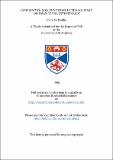Lymphocyte-like functions in the solitary ascidian 'Ciona intestinalis'
Abstract
The blood cells of the solitary ascidian, Ciona intestinalis, were examined for lymphocyte-like functions with a view to clarifying the phylogenetic origin of lymphocytes in invertebrates. It was found that cells, present in the circulating blood, mediate the haemolysis of sheep red blood cells, and that a different cell type mediates cytotoxic activity against a range of mammalian tumour cell lines in vitro. The blood cells, cytotoxic to mammalian cell lines, were enriched by continuous density gradient centrifugation, and their activity was ameliorated by heat-treatment. Parameters of cytotoxic activity against the target cell line, WEHI, a mouse myelomonocytic leukemic cell (strain 3B), were ascertained by fluorochromasia and the phenomenon was found to be rapid, temperature dependent and sensitive to osmotic conditions. Cytotoxicity was also found to be dependent upon the presence of magnesium and calcium ions, effector to target cell binding, and active metabolic, cytoskeletal and secretory processes in the effector cells. The cytotoxic cells were non-adherent to glass or nylon wool and transmission electron microscope studies of the target-binding cells showed that they were undifferentiated, with a high nucleus to cytoplasm ratio, containing a few large mitochondria, some profiles of rough endoplasmic reticulum and many free ribosomes. In addition, TEM studies revealed close inter-digitation of the effector and target cell membranes and evidence of secretory activity within the effector cell, in the area of target cell binding. The effector cell population was cultured in vitro and proliferation in response to concanavalin A, phytohaemagglutinin-B, lipopolysaccharide, or allogeneic leucocytes, measured by the uptake of tritiated thymidine, showed that these cells respond to both T and B cell mitogens and exhibit a mixed leucocyte reaction. In addition, the culture of pharyngeal explants and the measurement of cytotoxic activity by cells migrating from the explants indicates that the cytotoxic cells originate in a thymus-like haemopoietic tissue. Therefore, the undifferentiated blood cells of C. intestinalis, possess functional and morphological properties consistent with phylogenetic precursors of vertebrate lymphocytes.
Type
Thesis, PhD Doctor of Philosophy
Collections
Items in the St Andrews Research Repository are protected by copyright, with all rights reserved, unless otherwise indicated.

